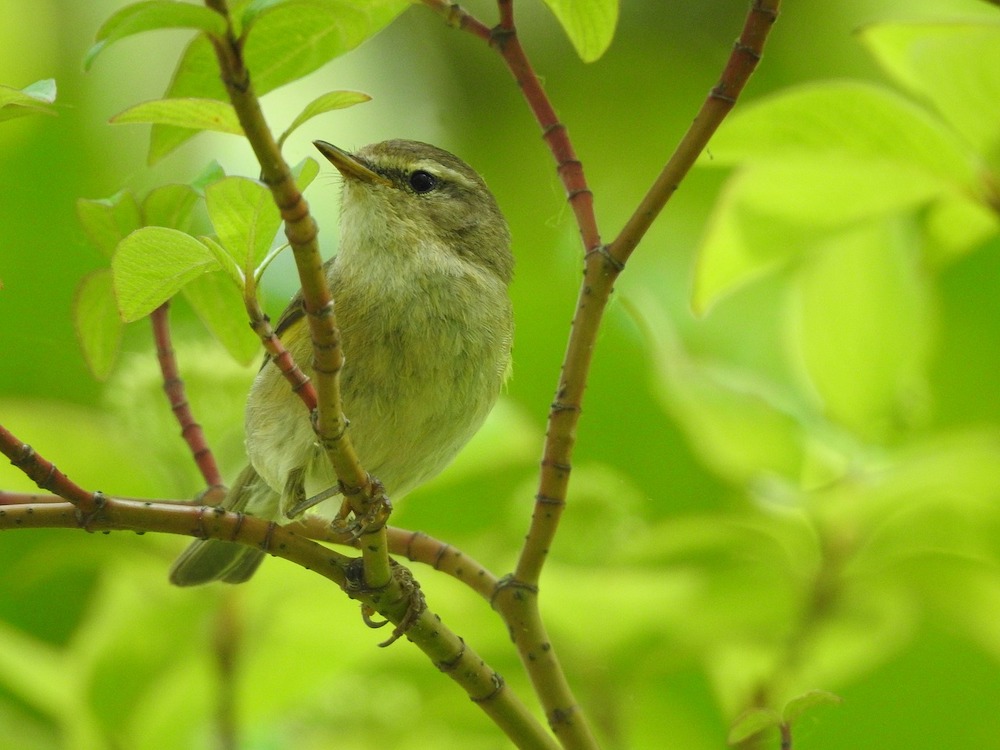An examination of perched Willow Warblers Phylloscopus trochilus singing on one leg
DOI:
https://doi.org/10.34080/os.v32.22447Keywords:
Sweden, songbird, Passeriformes, thermoregulationAbstract
Territory-holding male Willow Warblers Phylloscopus trochilus stood on one leg when they were singing at song posts for extended periods of time. The other leg was tucked in the breast plumage and not visible. The length of time spent on a twig was positively correlated to the use of unipedal stance. Observed birds spent longer pose time perched on one leg than on two legs. The right leg and the left leg were used at similar frequencies. The reason for this behaviour might be to save energy, by reducing heat loss through the skin of the tucked leg.
Downloads
References
Anderson MJ & Williams SA. 2010. Why do flamingos stand on one leg? Zoo Biology 29: 365–374. https://doi.org/10.1002/zoo.20266 DOI: https://doi.org/10.1002/zoo.20266
Arvidsson BL. 1992. Copulation and mate guarding in the willow warbler. Animal Behaviour 43: 501–509. https://doi.org/10.1016/S0003-3472(05)80108-3 DOI: https://doi.org/10.1016/S0003-3472(05)80108-3
Baudinette RV, Loveridge JP, Wilson KJ, Mills CD & Schmidt-Nielsen K. 1976. Heat loss from feet of herring gulls at rest and during flight. American Journal of Physiology 230: 920–924. https://doi.org/10.1152/ajplegacy.1976.230.4.920 DOI: https://doi.org/10.1152/ajplegacy.1976.230.4.920
Bouchard LC & Anderson MJ. 2011. Caribbean flamingo resting behaviour and the influence of weather variables. Journal of Ornithology 152: 307–312. https://doi.org/10.1007/s10336-010-0586-9 DOI: https://doi.org/10.1007/s10336-010-0586-9
Brock SE. 1910. The Willow-wrens in a Lothian wood. Zoologist 14: 401–417. DOI: https://doi.org/10.1002/path.1700140310
Clark GA Jr. 1973. Unipedal postures in birds. Bird-Banding 44: 22–26. https://doi.org/10.2307/4511925 DOI: https://doi.org/10.2307/4511925
Garamszegi LZ, Moreno J & Möller AP. 2006. Avian song complexity is associated with high field metabolic rate. Evolutionary Ecology Research 8: 75–90.
Gil D, Graves J & Slater PJB. 1999. Seasonal patterns of singing in the willow warbler: evidence against the fertility announcement hypothesis. Animal Behaviour 137: 759–782. https://doi.org/10.1006/anbe.1999.1211 DOI: https://doi.org/10.1163/156853900502330
Hedenström A & Pettersson J. 1986. Differences in fat deposits and wing pointedness between male and female Willow Warblers caught on spring migration at Ottenby, SE Sweden. Ornis Scandinavica 17: 182–185. https://doi.org/10.2307/3676868 DOI: https://doi.org/10.2307/3676868
Jakobsson S. 1988. Territorial fidelity of willow warbler (Phylloscopus trochilus) males and success in competition over territories. Behavioural Ecology and Sociobiology 22: 79–84. https://doi.org/10.1007/BF00303541 DOI: https://doi.org/10.1007/BF00303541
Kahl MP. 1963. Thermoregulation in the wood stork, with special reference to the role of the legs. Physiological Zoology 36: 141–152. https://doi.org/10.1086/physzool.36.2.30155437 DOI: https://doi.org/10.1086/physzool.36.2.30155437
Kilgore DL Jr & Schmidt-Nielsen K. 1975. Heat loss from duck’s feet immersed in cold water. Condor 77: 475–517. https://doi.org/10.2307/1366094 DOI: https://doi.org/10.2307/1366094
Lambrechts M & Dhondt AA. 1988. The anti-exhaustion hypothesis: a new hypothesis to explain song performance and song switching in the great tit. Animal Behaviour 36: 327–334. https://doi.org/10.1016/S0003-3472(88)80002-2 DOI: https://doi.org/10.1016/S0003-3472(88)80002-2
May DJ. 1949. Studies on a community of Willow Warblers. Ibis 91: 24–54. https://doi.org/10.1111/j.1474-919X.1949.tb02234.x DOI: https://doi.org/10.1111/j.1474-919X.1949.tb02234.x
Nyström KGK. 1987. Song-rates, territory size and time, budget in Willow Warblers, Phylloscopus trochilus. Vår Fågelvärld 46: 64–70.
Nyström KGK. 1991. On sex-specific foraging behaviour in the Willow Warbler, Phylloscopus trochilus. Canadian Journal of Zoology 69: 462–470. https://doi.org/10.1139/z91-072 DOI: https://doi.org/10.1139/z91-072
Nyström KGK. 1997. Food density, song rate, and body condition in territory-establishing willow warblers (Phylloscopus trochilus). Canadian Journal of Zoology 75: 47–58. https://doi.org/10.1139/z97-006 DOI: https://doi.org/10.1139/z97-006
Oberweger K & Goller F. 2001. The metabolic cost of birdsong production. Journal of Experimental Biology 204: 3379–3388. https://doi.org/10.1242/jeb.204.19.3379 DOI: https://doi.org/10.1242/jeb.204.19.3379
Radesäter T, Jakobsson S, Andbjer N, Bylin A & Nyström K. 1987. Song rate and pair formation in the willow warbler, Phylloscopus trochilus. Animal Behaviour 35: 1645–1651. https://doi.org/10.1016/S0003-3472(87)80057-X DOI: https://doi.org/10.1016/S0003-3472(87)80057-X
Ryeland J, Weston MA & Symonds MRE. 2019. Leg length and temperature determine the use of unipedal roosting in birds. Journal of Avian Biology 50: e02008. https://doi.org/10.1111/jav.02008 DOI: https://doi.org/10.1111/jav.02008
Steen I & Steen JS. 1965. The importance of the legs in the thermoregulation of birds. Acta Physiologica Scandinavica 63: 285–291. DOI: https://doi.org/10.1111/j.1748-1716.1965.tb04067.x
Tiainen J. 1982. Ecological significance of morphometric variation in three sympatric Phylloscopus warblers. Annales Zoologici Fennici 19: 285–295. https://www.jstor.org/stable/23734871
Tiainen J & Hanski IK. 1985. Wing shape variation of Finnish and Central European Willow Warblers Phylloscopus trochilus and Chiffchaffs P. collybita. Ibis 127: 365–371. https://doi.org/10.1111/j.1474-919X.1985.tb05078.x DOI: https://doi.org/10.1111/j.1474-919X.1985.tb05078.x
Ward S, Lampe HM & Slater PJB. 2004. Singing is not energetically demanding for pied flycatchers, Ficedula hypoleuca. Behavioral Ecology 15: 477–484. https://doi.org/10.1093/beheco/arh038 DOI: https://doi.org/10.1093/beheco/arh038
Ward S & Slater PJB. 2005. Raised thermoregulatory costs at exposed song posts increase the energetic cost of singing for willow warblers Phylloscopus trochilus. Journal of Avian Biology 36: 280–286. https://doi.org/10.1111/j.0908-8857.2005.03379.x DOI: https://doi.org/10.1111/j.0908-8857.2005.03379.x
Webster MD & Weathers WW. 1990. Heat produced as a by-product of foraging activity contribute to thermoregulation by verdins, Auriparus flaviceps. Physiological Zoology 63: 777–794. https://doi.org/10.1086/physzool.63.4.30158176 DOI: https://doi.org/10.1086/physzool.63.4.30158176
Zerba E, Dana AN & Lucia MA. 1999. The influence of Wind and Locomotor Activity on Surface Temperature and Energy Expenditure of the Eastern House Finch (Carpodacus mexicanus) during Cold Stress. Physiological and Biochemical Zoology 72: 265–276. https://doi.org/10.1086/316665 DOI: https://doi.org/10.1086/316665

Downloads
Published
How to Cite
Issue
Section
License
Copyright (c) 2022 K G Kenneth Nyström

This work is licensed under a Creative Commons Attribution 4.0 International License.
The copyright of each contribution belongs to the author(s), but all contributions are published under a Creative Commons license, so that anyone is free to share and reuse the contribution as long as the copyright holder is attributed.







